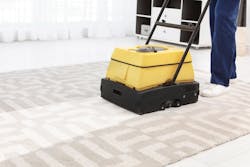Keeping carpeting and flooring clean and well-maintained is a year-round responsibility for education institutions, but for most schools and universities, the approach of summer provides an opportunity to carry out the more extensive maintenance and thorough cleaning that isn’t feasible the rest of the year when corridors and classrooms are crowded with students scuffing the floors and tramping in dirt.
For carpeting, periodic wet extraction cleaning will help carpet last longer and maintain its appearance; extraction also will remove substances trapped in a carpet that less extensive cleaning methods have left behind.
Inadequate carpet cleaning may result in dirt and other substances to become ground into the carpet backing; at that point, removing the dirt becomes more difficult and may damage carpet fiber, and the carpeting may have to be replaced. In the meantime, the allergens, dirt and other potentially harmful substances left behind may lead to poor indoor air quality and cause health problems for students and staff.
Scheduling deep cleaning when facilities are mostly empty in the summer will help workers avoid the traffic and obstacles that could make cleaning inefficient or ineffective.
The Collaborative for High Performance Schools Best Practices Manual recommends that schools carry out extraction cleaning of carpets before classes resume in late summer or fall. Crews should minimize the amount of cleaner used. “Excess cleaner can lead to rapid resoiling of the carpet,” the manual states.
Workers also should make sure that their extraction equipment is operating properly. If the equipment is not extracting the maximum amount of moisture from a carpet, what is left behind “can lead to serious IAQ problems from mold and mildew growth,” the manual says.
After extraction, crews should use fans and natural ventilation for 48 hours to air out the space and dry the carpet properly and prevent the growth of mold and other harmful substances.
Summer is also an opportune time for schools and universities to do more extensive cleaning of their hard floor surfaces. Stripping and waxing remove the dirt and other unwanted substances that build up on the floor. The cleaning process creates a barrier between the floor and the dirt tracked in by students. Most experts recommend stripping and rewaxing resilient floor surfaces at least once a year. Areas with a high volume of foot traffic like a school corridor may need to be stripped and waxed more frequently.
The CHPS Best Practices Manual emphasizes that a floor finish should be compatible with the stripping solution used. Schools should give preference to stripping solutions with a neutral pH (closer to 7), and seek stripping solutions that emit little or no volatile organic compounds.
Periodic buffing with a slow speed buffer will remove most scuff marks and light scratches. Buffing also will add luster while dislodging dirt and blending touch-up spots. Difficult scuff marks that aren't removed by mopping or buffing can be removed using a nylon scouring pad. Use a solution of neutral floor cleaning detergent, rub gently, and rinse well afterward, the manual recommends.
A finish that is more durable to reduce the need for additional buffing, restoring and recoating.
Movable chairs, tables, desks and other objects that may dig into the floor should be outfitted with floor guards or casters on the bottoms of each leg to prevent scuffs and scratches.
Be sure floors are thoroughly cleaned and dried before applying a finish. Never apply a finish to a dirty floor because it will trap the dirt under the surface.
Wood flooring is a less common surface in school facilities, but it is frequently found in gymnasiums. Wood floors require annual screening and resealing with a water-based sealant, the manual says. Again, summer may be the best time to do that, but school administrators must be mindful of summer schedules, even if no students are attending classes in the building. Districts often open up such facilities for use by summer camps or recreation programs and their schedules may conflict with the staff's cleaning plans.
Once summer is over and students have returned to class, the intensive summertime cleaning will be more effective if crews stay vigilant with sweeping, mopping, spot cleaning and other daily maintenance during the school year.
About the Author
Mike Kennedy
Senior Editor
Mike Kennedy, senior editor, has written for AS&U on a wide range of educational issues since 1999.
